Review of Collaboration in Healthcare and its Clinical Effectiveness
VerifiedAdded on 2022/08/21
|8
|1992
|12
Essay
AI Summary
This essay delves into the critical role of interprofessional collaboration (IC) in healthcare, emphasizing its impact on patient care and clinical effectiveness. The author highlights the benefits of teamwork and the importance of patient and family involvement in decision-making. The essay reviews three studies that explore factors influencing IC, such as patient-related, professional, and organizational aspects. It discusses how effective communication, shared goals, and the expertise of various healthcare professionals contribute to improved patient outcomes, including positive perceptions of care and increased job satisfaction for healthcare staff. Furthermore, the essay underscores the value of collaborative efforts like regular team meetings and prioritization in achieving successful IC, ultimately advocating for early exposure of medical students to collaborative environments to enhance their skills in this critical area. The essay draws on various research articles to support its claims, offering insights into the current practices and perspectives on collaboration within the healthcare sector.
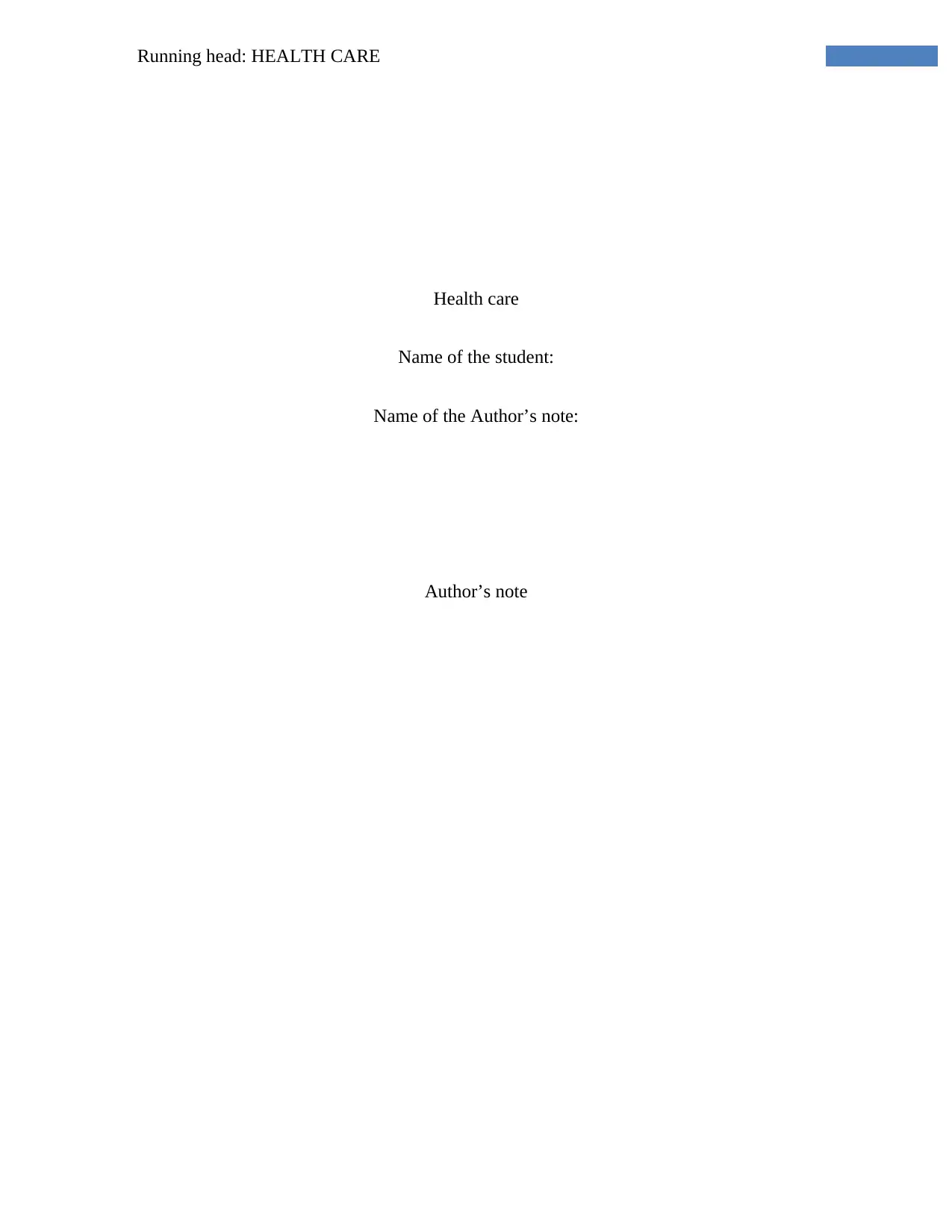
Running head: HEALTH CARE
Health care
Name of the student:
Name of the Author’s note:
Author’s note
Health care
Name of the student:
Name of the Author’s note:
Author’s note
Paraphrase This Document
Need a fresh take? Get an instant paraphrase of this document with our AI Paraphraser
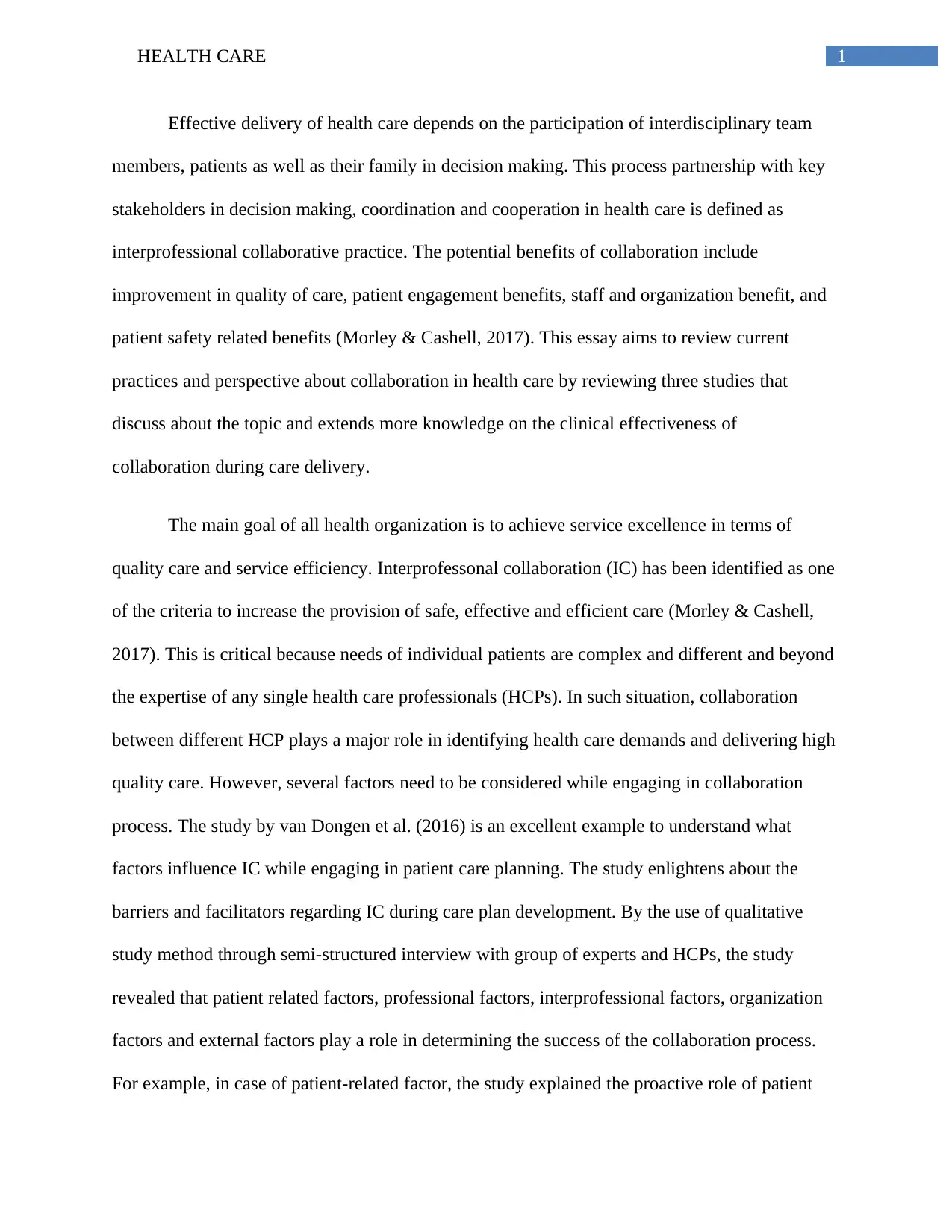
1HEALTH CARE
Effective delivery of health care depends on the participation of interdisciplinary team
members, patients as well as their family in decision making. This process partnership with key
stakeholders in decision making, coordination and cooperation in health care is defined as
interprofessional collaborative practice. The potential benefits of collaboration include
improvement in quality of care, patient engagement benefits, staff and organization benefit, and
patient safety related benefits (Morley & Cashell, 2017). This essay aims to review current
practices and perspective about collaboration in health care by reviewing three studies that
discuss about the topic and extends more knowledge on the clinical effectiveness of
collaboration during care delivery.
The main goal of all health organization is to achieve service excellence in terms of
quality care and service efficiency. Interprofessonal collaboration (IC) has been identified as one
of the criteria to increase the provision of safe, effective and efficient care (Morley & Cashell,
2017). This is critical because needs of individual patients are complex and different and beyond
the expertise of any single health care professionals (HCPs). In such situation, collaboration
between different HCP plays a major role in identifying health care demands and delivering high
quality care. However, several factors need to be considered while engaging in collaboration
process. The study by van Dongen et al. (2016) is an excellent example to understand what
factors influence IC while engaging in patient care planning. The study enlightens about the
barriers and facilitators regarding IC during care plan development. By the use of qualitative
study method through semi-structured interview with group of experts and HCPs, the study
revealed that patient related factors, professional factors, interprofessional factors, organization
factors and external factors play a role in determining the success of the collaboration process.
For example, in case of patient-related factor, the study explained the proactive role of patient
Effective delivery of health care depends on the participation of interdisciplinary team
members, patients as well as their family in decision making. This process partnership with key
stakeholders in decision making, coordination and cooperation in health care is defined as
interprofessional collaborative practice. The potential benefits of collaboration include
improvement in quality of care, patient engagement benefits, staff and organization benefit, and
patient safety related benefits (Morley & Cashell, 2017). This essay aims to review current
practices and perspective about collaboration in health care by reviewing three studies that
discuss about the topic and extends more knowledge on the clinical effectiveness of
collaboration during care delivery.
The main goal of all health organization is to achieve service excellence in terms of
quality care and service efficiency. Interprofessonal collaboration (IC) has been identified as one
of the criteria to increase the provision of safe, effective and efficient care (Morley & Cashell,
2017). This is critical because needs of individual patients are complex and different and beyond
the expertise of any single health care professionals (HCPs). In such situation, collaboration
between different HCP plays a major role in identifying health care demands and delivering high
quality care. However, several factors need to be considered while engaging in collaboration
process. The study by van Dongen et al. (2016) is an excellent example to understand what
factors influence IC while engaging in patient care planning. The study enlightens about the
barriers and facilitators regarding IC during care plan development. By the use of qualitative
study method through semi-structured interview with group of experts and HCPs, the study
revealed that patient related factors, professional factors, interprofessional factors, organization
factors and external factors play a role in determining the success of the collaboration process.
For example, in case of patient-related factor, the study explained the proactive role of patient
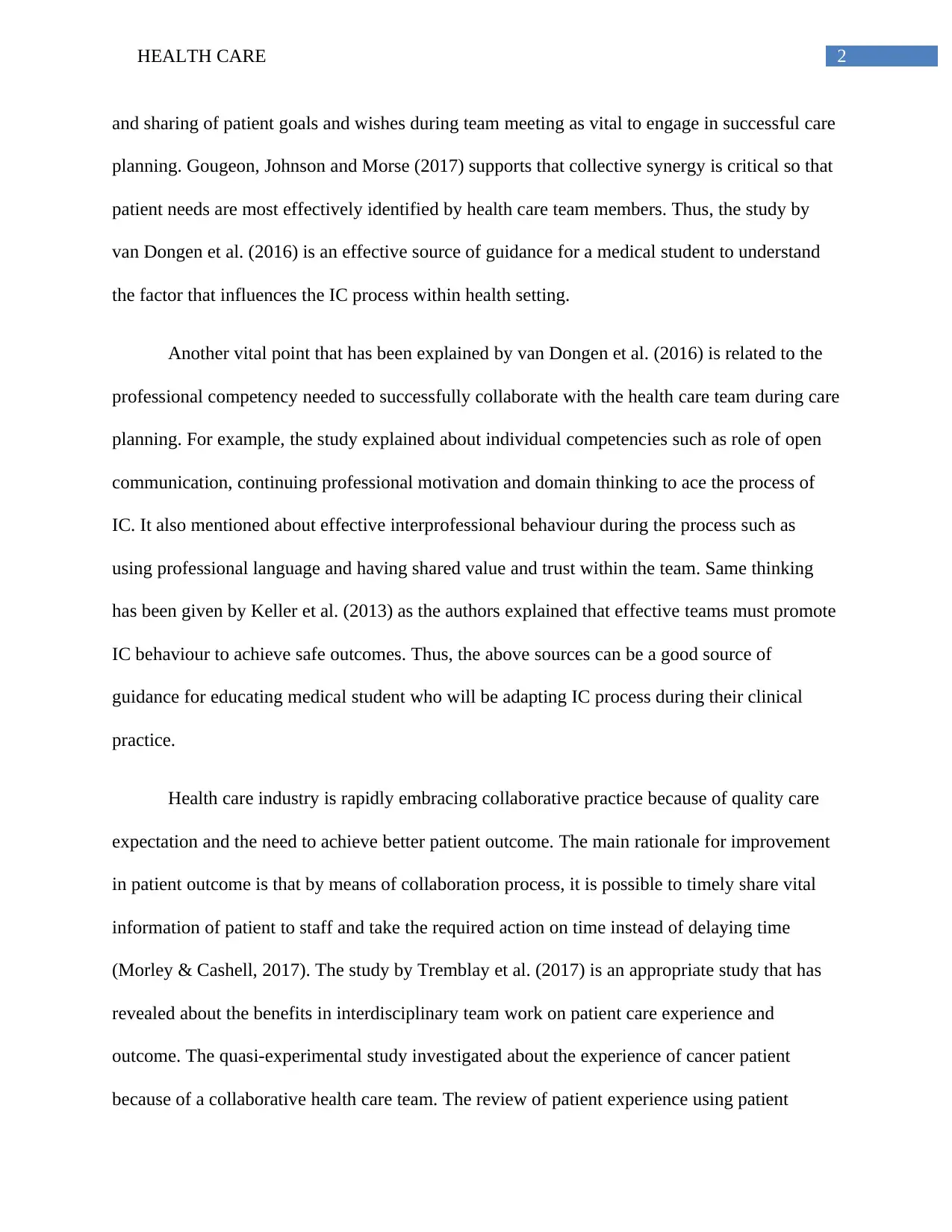
2HEALTH CARE
and sharing of patient goals and wishes during team meeting as vital to engage in successful care
planning. Gougeon, Johnson and Morse (2017) supports that collective synergy is critical so that
patient needs are most effectively identified by health care team members. Thus, the study by
van Dongen et al. (2016) is an effective source of guidance for a medical student to understand
the factor that influences the IC process within health setting.
Another vital point that has been explained by van Dongen et al. (2016) is related to the
professional competency needed to successfully collaborate with the health care team during care
planning. For example, the study explained about individual competencies such as role of open
communication, continuing professional motivation and domain thinking to ace the process of
IC. It also mentioned about effective interprofessional behaviour during the process such as
using professional language and having shared value and trust within the team. Same thinking
has been given by Keller et al. (2013) as the authors explained that effective teams must promote
IC behaviour to achieve safe outcomes. Thus, the above sources can be a good source of
guidance for educating medical student who will be adapting IC process during their clinical
practice.
Health care industry is rapidly embracing collaborative practice because of quality care
expectation and the need to achieve better patient outcome. The main rationale for improvement
in patient outcome is that by means of collaboration process, it is possible to timely share vital
information of patient to staff and take the required action on time instead of delaying time
(Morley & Cashell, 2017). The study by Tremblay et al. (2017) is an appropriate study that has
revealed about the benefits in interdisciplinary team work on patient care experience and
outcome. The quasi-experimental study investigated about the experience of cancer patient
because of a collaborative health care team. The review of patient experience using patient
and sharing of patient goals and wishes during team meeting as vital to engage in successful care
planning. Gougeon, Johnson and Morse (2017) supports that collective synergy is critical so that
patient needs are most effectively identified by health care team members. Thus, the study by
van Dongen et al. (2016) is an effective source of guidance for a medical student to understand
the factor that influences the IC process within health setting.
Another vital point that has been explained by van Dongen et al. (2016) is related to the
professional competency needed to successfully collaborate with the health care team during care
planning. For example, the study explained about individual competencies such as role of open
communication, continuing professional motivation and domain thinking to ace the process of
IC. It also mentioned about effective interprofessional behaviour during the process such as
using professional language and having shared value and trust within the team. Same thinking
has been given by Keller et al. (2013) as the authors explained that effective teams must promote
IC behaviour to achieve safe outcomes. Thus, the above sources can be a good source of
guidance for educating medical student who will be adapting IC process during their clinical
practice.
Health care industry is rapidly embracing collaborative practice because of quality care
expectation and the need to achieve better patient outcome. The main rationale for improvement
in patient outcome is that by means of collaboration process, it is possible to timely share vital
information of patient to staff and take the required action on time instead of delaying time
(Morley & Cashell, 2017). The study by Tremblay et al. (2017) is an appropriate study that has
revealed about the benefits in interdisciplinary team work on patient care experience and
outcome. The quasi-experimental study investigated about the experience of cancer patient
because of a collaborative health care team. The review of patient experience using patient
⊘ This is a preview!⊘
Do you want full access?
Subscribe today to unlock all pages.

Trusted by 1+ million students worldwide
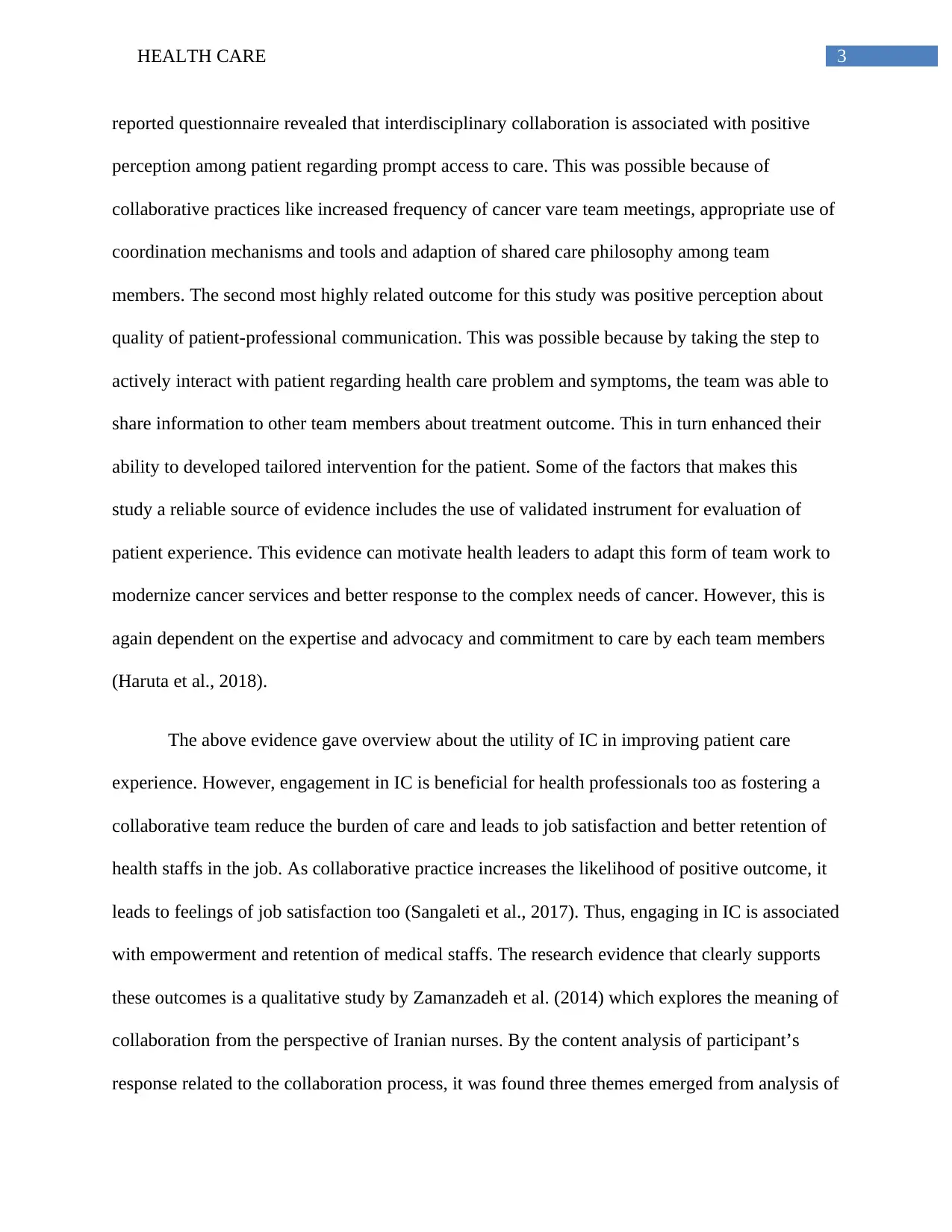
3HEALTH CARE
reported questionnaire revealed that interdisciplinary collaboration is associated with positive
perception among patient regarding prompt access to care. This was possible because of
collaborative practices like increased frequency of cancer vare team meetings, appropriate use of
coordination mechanisms and tools and adaption of shared care philosophy among team
members. The second most highly related outcome for this study was positive perception about
quality of patient-professional communication. This was possible because by taking the step to
actively interact with patient regarding health care problem and symptoms, the team was able to
share information to other team members about treatment outcome. This in turn enhanced their
ability to developed tailored intervention for the patient. Some of the factors that makes this
study a reliable source of evidence includes the use of validated instrument for evaluation of
patient experience. This evidence can motivate health leaders to adapt this form of team work to
modernize cancer services and better response to the complex needs of cancer. However, this is
again dependent on the expertise and advocacy and commitment to care by each team members
(Haruta et al., 2018).
The above evidence gave overview about the utility of IC in improving patient care
experience. However, engagement in IC is beneficial for health professionals too as fostering a
collaborative team reduce the burden of care and leads to job satisfaction and better retention of
health staffs in the job. As collaborative practice increases the likelihood of positive outcome, it
leads to feelings of job satisfaction too (Sangaleti et al., 2017). Thus, engaging in IC is associated
with empowerment and retention of medical staffs. The research evidence that clearly supports
these outcomes is a qualitative study by Zamanzadeh et al. (2014) which explores the meaning of
collaboration from the perspective of Iranian nurses. By the content analysis of participant’s
response related to the collaboration process, it was found three themes emerged from analysis of
reported questionnaire revealed that interdisciplinary collaboration is associated with positive
perception among patient regarding prompt access to care. This was possible because of
collaborative practices like increased frequency of cancer vare team meetings, appropriate use of
coordination mechanisms and tools and adaption of shared care philosophy among team
members. The second most highly related outcome for this study was positive perception about
quality of patient-professional communication. This was possible because by taking the step to
actively interact with patient regarding health care problem and symptoms, the team was able to
share information to other team members about treatment outcome. This in turn enhanced their
ability to developed tailored intervention for the patient. Some of the factors that makes this
study a reliable source of evidence includes the use of validated instrument for evaluation of
patient experience. This evidence can motivate health leaders to adapt this form of team work to
modernize cancer services and better response to the complex needs of cancer. However, this is
again dependent on the expertise and advocacy and commitment to care by each team members
(Haruta et al., 2018).
The above evidence gave overview about the utility of IC in improving patient care
experience. However, engagement in IC is beneficial for health professionals too as fostering a
collaborative team reduce the burden of care and leads to job satisfaction and better retention of
health staffs in the job. As collaborative practice increases the likelihood of positive outcome, it
leads to feelings of job satisfaction too (Sangaleti et al., 2017). Thus, engaging in IC is associated
with empowerment and retention of medical staffs. The research evidence that clearly supports
these outcomes is a qualitative study by Zamanzadeh et al. (2014) which explores the meaning of
collaboration from the perspective of Iranian nurses. By the content analysis of participant’s
response related to the collaboration process, it was found three themes emerged from analysis of
Paraphrase This Document
Need a fresh take? Get an instant paraphrase of this document with our AI Paraphraser
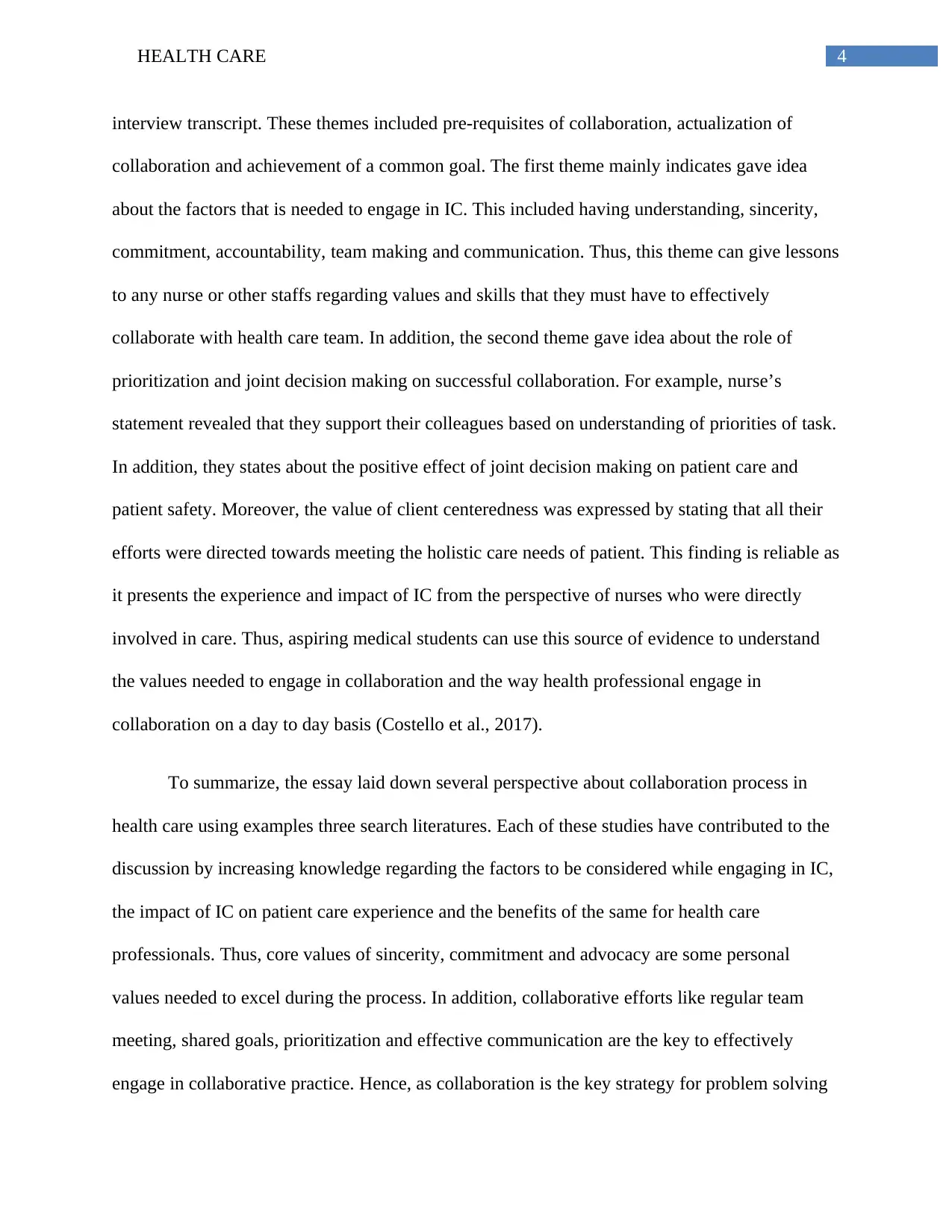
4HEALTH CARE
interview transcript. These themes included pre-requisites of collaboration, actualization of
collaboration and achievement of a common goal. The first theme mainly indicates gave idea
about the factors that is needed to engage in IC. This included having understanding, sincerity,
commitment, accountability, team making and communication. Thus, this theme can give lessons
to any nurse or other staffs regarding values and skills that they must have to effectively
collaborate with health care team. In addition, the second theme gave idea about the role of
prioritization and joint decision making on successful collaboration. For example, nurse’s
statement revealed that they support their colleagues based on understanding of priorities of task.
In addition, they states about the positive effect of joint decision making on patient care and
patient safety. Moreover, the value of client centeredness was expressed by stating that all their
efforts were directed towards meeting the holistic care needs of patient. This finding is reliable as
it presents the experience and impact of IC from the perspective of nurses who were directly
involved in care. Thus, aspiring medical students can use this source of evidence to understand
the values needed to engage in collaboration and the way health professional engage in
collaboration on a day to day basis (Costello et al., 2017).
To summarize, the essay laid down several perspective about collaboration process in
health care using examples three search literatures. Each of these studies have contributed to the
discussion by increasing knowledge regarding the factors to be considered while engaging in IC,
the impact of IC on patient care experience and the benefits of the same for health care
professionals. Thus, core values of sincerity, commitment and advocacy are some personal
values needed to excel during the process. In addition, collaborative efforts like regular team
meeting, shared goals, prioritization and effective communication are the key to effectively
engage in collaborative practice. Hence, as collaboration is the key strategy for problem solving
interview transcript. These themes included pre-requisites of collaboration, actualization of
collaboration and achievement of a common goal. The first theme mainly indicates gave idea
about the factors that is needed to engage in IC. This included having understanding, sincerity,
commitment, accountability, team making and communication. Thus, this theme can give lessons
to any nurse or other staffs regarding values and skills that they must have to effectively
collaborate with health care team. In addition, the second theme gave idea about the role of
prioritization and joint decision making on successful collaboration. For example, nurse’s
statement revealed that they support their colleagues based on understanding of priorities of task.
In addition, they states about the positive effect of joint decision making on patient care and
patient safety. Moreover, the value of client centeredness was expressed by stating that all their
efforts were directed towards meeting the holistic care needs of patient. This finding is reliable as
it presents the experience and impact of IC from the perspective of nurses who were directly
involved in care. Thus, aspiring medical students can use this source of evidence to understand
the values needed to engage in collaboration and the way health professional engage in
collaboration on a day to day basis (Costello et al., 2017).
To summarize, the essay laid down several perspective about collaboration process in
health care using examples three search literatures. Each of these studies have contributed to the
discussion by increasing knowledge regarding the factors to be considered while engaging in IC,
the impact of IC on patient care experience and the benefits of the same for health care
professionals. Thus, core values of sincerity, commitment and advocacy are some personal
values needed to excel during the process. In addition, collaborative efforts like regular team
meeting, shared goals, prioritization and effective communication are the key to effectively
engage in collaborative practice. Hence, as collaboration is the key strategy for problem solving

5HEALTH CARE
and innovation in the health care system. The medical nursing college must realize the need to
expose medical students to appropriate environment so that they excel in the practice of
collaboration much before actual practice.
and innovation in the health care system. The medical nursing college must realize the need to
expose medical students to appropriate environment so that they excel in the practice of
collaboration much before actual practice.
⊘ This is a preview!⊘
Do you want full access?
Subscribe today to unlock all pages.

Trusted by 1+ million students worldwide
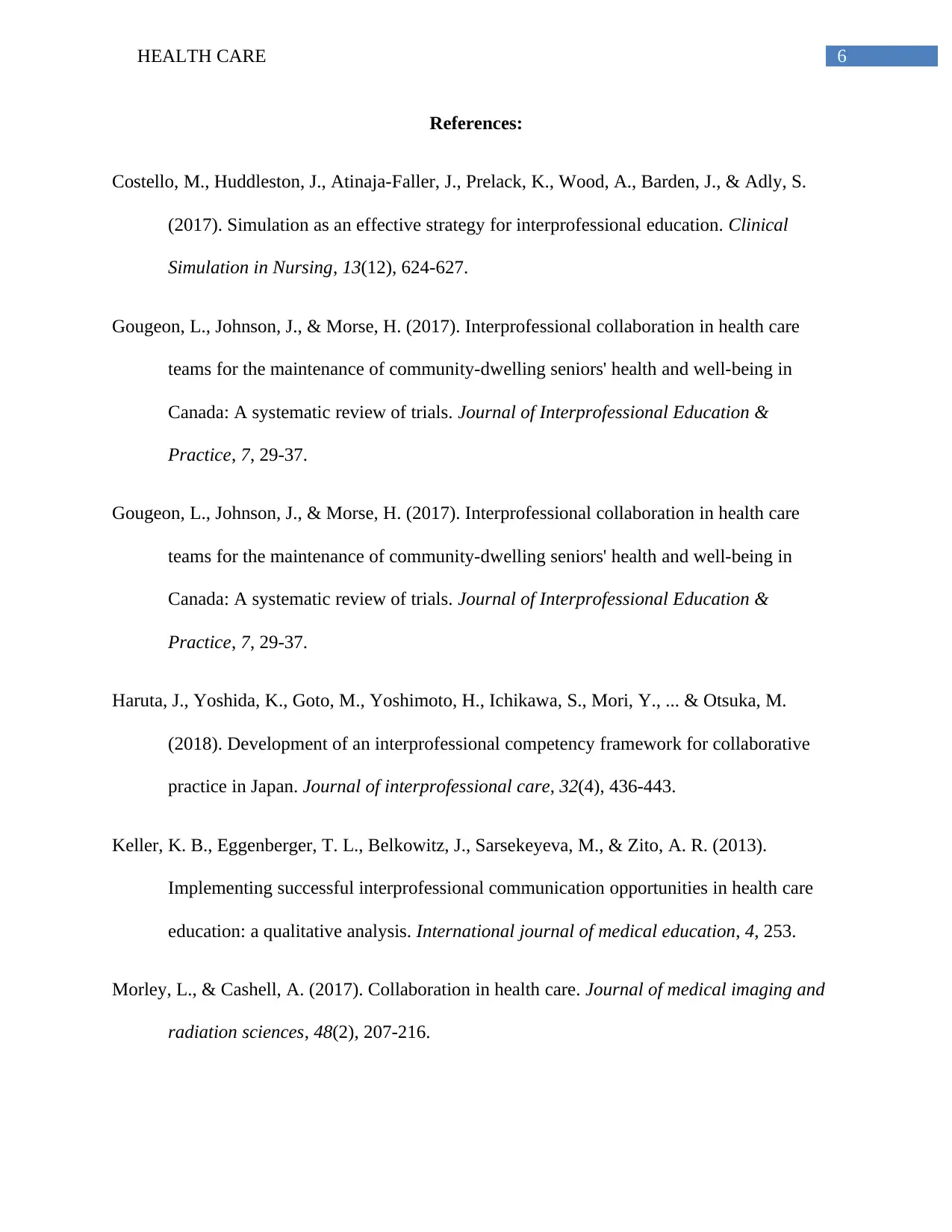
6HEALTH CARE
References:
Costello, M., Huddleston, J., Atinaja-Faller, J., Prelack, K., Wood, A., Barden, J., & Adly, S.
(2017). Simulation as an effective strategy for interprofessional education. Clinical
Simulation in Nursing, 13(12), 624-627.
Gougeon, L., Johnson, J., & Morse, H. (2017). Interprofessional collaboration in health care
teams for the maintenance of community-dwelling seniors' health and well-being in
Canada: A systematic review of trials. Journal of Interprofessional Education &
Practice, 7, 29-37.
Gougeon, L., Johnson, J., & Morse, H. (2017). Interprofessional collaboration in health care
teams for the maintenance of community-dwelling seniors' health and well-being in
Canada: A systematic review of trials. Journal of Interprofessional Education &
Practice, 7, 29-37.
Haruta, J., Yoshida, K., Goto, M., Yoshimoto, H., Ichikawa, S., Mori, Y., ... & Otsuka, M.
(2018). Development of an interprofessional competency framework for collaborative
practice in Japan. Journal of interprofessional care, 32(4), 436-443.
Keller, K. B., Eggenberger, T. L., Belkowitz, J., Sarsekeyeva, M., & Zito, A. R. (2013).
Implementing successful interprofessional communication opportunities in health care
education: a qualitative analysis. International journal of medical education, 4, 253.
Morley, L., & Cashell, A. (2017). Collaboration in health care. Journal of medical imaging and
radiation sciences, 48(2), 207-216.
References:
Costello, M., Huddleston, J., Atinaja-Faller, J., Prelack, K., Wood, A., Barden, J., & Adly, S.
(2017). Simulation as an effective strategy for interprofessional education. Clinical
Simulation in Nursing, 13(12), 624-627.
Gougeon, L., Johnson, J., & Morse, H. (2017). Interprofessional collaboration in health care
teams for the maintenance of community-dwelling seniors' health and well-being in
Canada: A systematic review of trials. Journal of Interprofessional Education &
Practice, 7, 29-37.
Gougeon, L., Johnson, J., & Morse, H. (2017). Interprofessional collaboration in health care
teams for the maintenance of community-dwelling seniors' health and well-being in
Canada: A systematic review of trials. Journal of Interprofessional Education &
Practice, 7, 29-37.
Haruta, J., Yoshida, K., Goto, M., Yoshimoto, H., Ichikawa, S., Mori, Y., ... & Otsuka, M.
(2018). Development of an interprofessional competency framework for collaborative
practice in Japan. Journal of interprofessional care, 32(4), 436-443.
Keller, K. B., Eggenberger, T. L., Belkowitz, J., Sarsekeyeva, M., & Zito, A. R. (2013).
Implementing successful interprofessional communication opportunities in health care
education: a qualitative analysis. International journal of medical education, 4, 253.
Morley, L., & Cashell, A. (2017). Collaboration in health care. Journal of medical imaging and
radiation sciences, 48(2), 207-216.
Paraphrase This Document
Need a fresh take? Get an instant paraphrase of this document with our AI Paraphraser
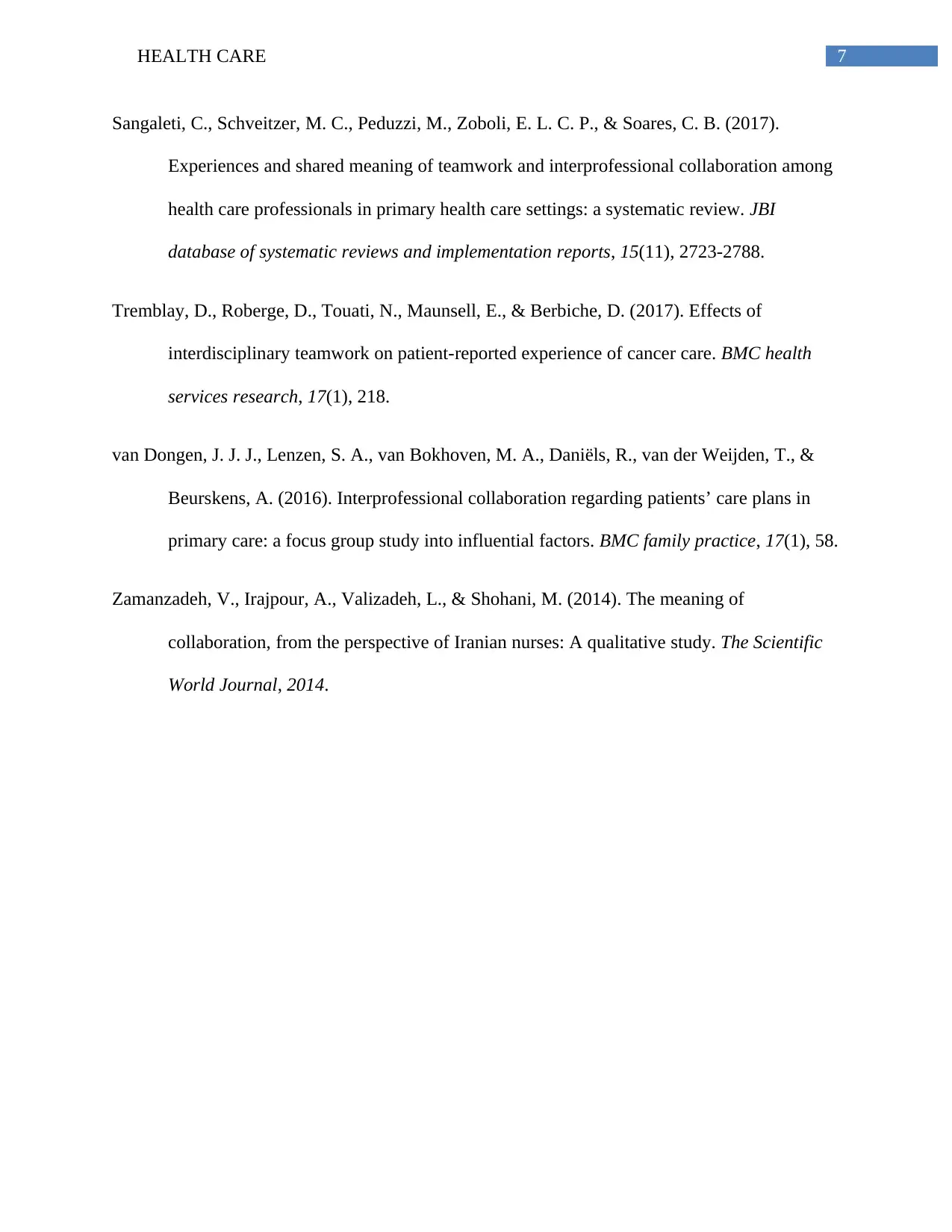
7HEALTH CARE
Sangaleti, C., Schveitzer, M. C., Peduzzi, M., Zoboli, E. L. C. P., & Soares, C. B. (2017).
Experiences and shared meaning of teamwork and interprofessional collaboration among
health care professionals in primary health care settings: a systematic review. JBI
database of systematic reviews and implementation reports, 15(11), 2723-2788.
Tremblay, D., Roberge, D., Touati, N., Maunsell, E., & Berbiche, D. (2017). Effects of
interdisciplinary teamwork on patient-reported experience of cancer care. BMC health
services research, 17(1), 218.
van Dongen, J. J. J., Lenzen, S. A., van Bokhoven, M. A., Daniëls, R., van der Weijden, T., &
Beurskens, A. (2016). Interprofessional collaboration regarding patients’ care plans in
primary care: a focus group study into influential factors. BMC family practice, 17(1), 58.
Zamanzadeh, V., Irajpour, A., Valizadeh, L., & Shohani, M. (2014). The meaning of
collaboration, from the perspective of Iranian nurses: A qualitative study. The Scientific
World Journal, 2014.
Sangaleti, C., Schveitzer, M. C., Peduzzi, M., Zoboli, E. L. C. P., & Soares, C. B. (2017).
Experiences and shared meaning of teamwork and interprofessional collaboration among
health care professionals in primary health care settings: a systematic review. JBI
database of systematic reviews and implementation reports, 15(11), 2723-2788.
Tremblay, D., Roberge, D., Touati, N., Maunsell, E., & Berbiche, D. (2017). Effects of
interdisciplinary teamwork on patient-reported experience of cancer care. BMC health
services research, 17(1), 218.
van Dongen, J. J. J., Lenzen, S. A., van Bokhoven, M. A., Daniëls, R., van der Weijden, T., &
Beurskens, A. (2016). Interprofessional collaboration regarding patients’ care plans in
primary care: a focus group study into influential factors. BMC family practice, 17(1), 58.
Zamanzadeh, V., Irajpour, A., Valizadeh, L., & Shohani, M. (2014). The meaning of
collaboration, from the perspective of Iranian nurses: A qualitative study. The Scientific
World Journal, 2014.
1 out of 8
Related Documents
Your All-in-One AI-Powered Toolkit for Academic Success.
+13062052269
info@desklib.com
Available 24*7 on WhatsApp / Email
![[object Object]](/_next/static/media/star-bottom.7253800d.svg)
Unlock your academic potential
Copyright © 2020–2025 A2Z Services. All Rights Reserved. Developed and managed by ZUCOL.





